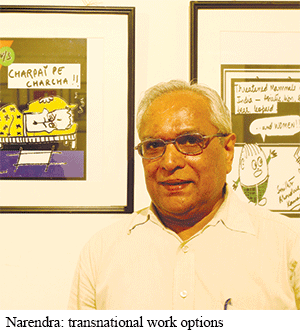The vintage art of caricature manifested in front page illustrations and cartoon strips of newspapers, has morphed into a lucrative multi-media career option - Odeal D’Souza
 With the growth of computer-aided graphics, animation software technologies and expansion of the Internet user base, the vintage art of caricature as manifested in front page illustrations and cartoon strips of newspapers and magazines, has morphed into a lucrative digital animation and multimedia career option.
With the growth of computer-aided graphics, animation software technologies and expansion of the Internet user base, the vintage art of caricature as manifested in front page illustrations and cartoon strips of newspapers and magazines, has morphed into a lucrative digital animation and multimedia career option.
21st century graphic illustrators are artists who work in diverse fields ranging from editorial cartoonists of newspapers and publishing houses (magazines and textbooks), to digital artists of computer games, animation films, Internet advertisements, web comics and strips, graphic novels, greeting cards etc. While most editorial cartoonists use conventional pen and ink to showcase their art in print media, digital illustrators use sophisticated computer-aided software technologies.
Study programmes
A flair for and ability to draw/sketch, with an eye for detail and exceptional observation skills are prerequisites of aspiring illustrators. A sense of humour and imagination and knowledge of the host nation’s socio-cultural milieu and political affairs are other required capabilities. A bachelor’s degree in political science or journalism is a good foundation for graphic illustrators aspiring to work in the media.
India’s government-controlled higher ed system doesn’t permit formal degree programmes in cartooning/illustration. Therefore, a bachelor’s or postgrad degree in fine arts supplemented with part-time courses in animation and graphic art software such as Photoshop CS 5 and Corel Painter 12 are useful qualifications.
Among top-ranked institutions in India which offer bachelor’s and postgraduate study programmes in fine arts are the Banaras Hindu University, Varanasi, University of Delhi, Sir J.J. School of Arts, Mumbai, Jamia Millia Islamia, Delhi, Bharati Kala Mahavidyalaya, Pune, Kurukshetra University, Haryana, Mahatma Gandhi Kashi Vidyapith, Varanasi, the L.S. Raheja School of Art, Mumbai and Aligarh Muslim University. Institutes offering digital animation courses include Maya Academy of Advanced Cinematics (MAAC), Mumbai, Picasso Animation College, Delhi, National Institute of Design, Ahmedabad, Global School of Animation and Games, Delhi, Toonz Academy, Trivandrum among others.
Moreover, the Indian Institute of Cartoonists, Bangalore and Kerala Cartoon Academy, Kochi conduct workshops throughout the year for illustrators.
Pay and progression
An editorial or political cartoonist in the newspaper industry typically starts with a salary of Rs.15,000 per month. With a minimum of five years work experience in the print media, she could expect gross remuneration of Rs.3-4 lakh per year. Illustrators working with animation studios, in-house e-magazines for MNCs, cartoon networks, and advertising agencies usually start at Rs.20,000 per month which could rise to Rs.50,000 within two years. For freelancers, an accepted illustration/cartoon could earn between Rs.1,000-5,000 depending on reputation and experience.
Professional profile
“In the new world order of digitisation and the Internet, there’s huge and growing demand for graphic artists, illustrators and cartoonists,” says V.G. Narendra, a self-taught political cartoonist and currently trustee of the Bangalore-based Indian Institute of Cartoonists (IIC, estb. 2001) and the Indian Cartoon Gallery (estb. 2007).
A science alumnus of Dharwad University (Karnataka), Narendra started dabbling in art during his undergrad years. In 1970 after graduation, he migrated to Mumbai and freelanced for The Illustrated Weekly of India and Dharamyug.
In 1972, he signed up with Ranga Rekha Features, Mumbai — India’s first comic features syndicate — following which his Reporter Sanju cartoon character who commented on political and social issues, was syndicated in 15 English and vernacular dailies in Maharashtra and peninsular India. In 1973, Narendra moved base to Delhi where he signed up with Shankar’s Weekly, established in 1948 by the legendary cartoonist and satirist, Shankar Pillai. In 1976, back in Bangalore as cartoonist of Samyukta Karnataka, he promoted the Karnataka Cartoonists’ Association in 1977, while serving as political cartoonist of Kannada Prabha, before finally retiring in 1987.
“Today, graphic illustrators have a plethora of career and freelance options in the print and packaging, gaming and animation industries. Moreover, unlike in our younger days, visual artists have the option to work across national boundaries and generate clients around the world. For young people with drawing and sketching skills — and sharp political insights — there’s a bright future in the graphic arts,” says Narendra.